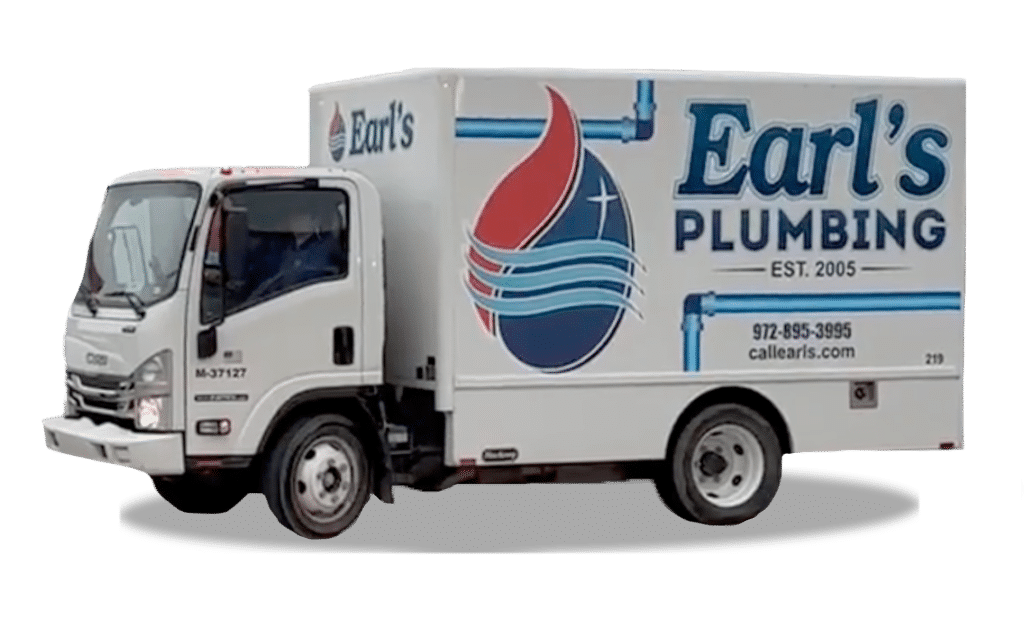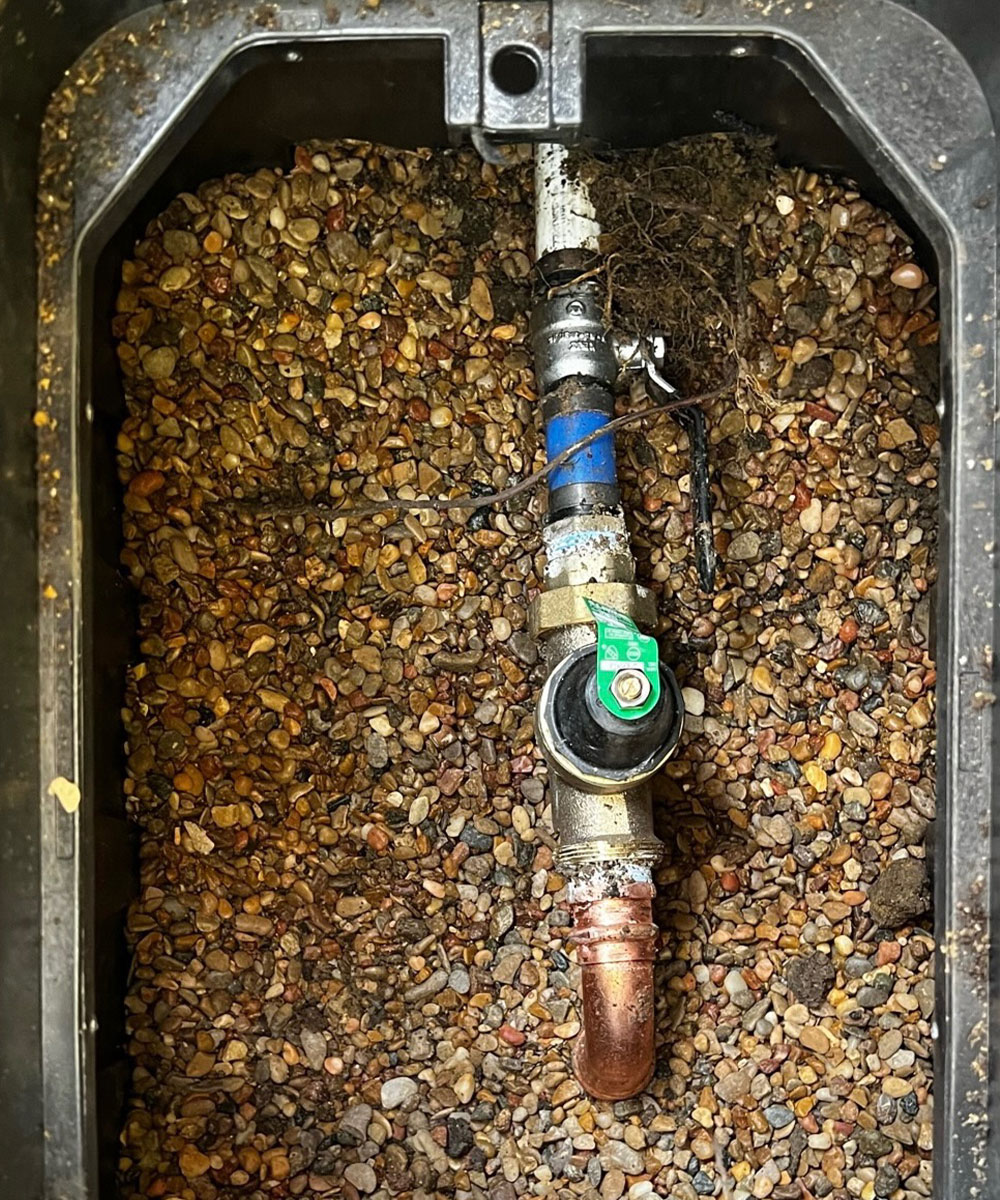Frisco’s Pressure Reducing Valve (PRV) Replacement Experts
Most homeowners aren’t aware of this small but mighty fixture on their main plumbing line. The pressure reducing valve (also called a pressure regulating valve or PRV) regulates the water pressure coming from the city. This ensures that high-pressure municipal water doesn’t damage your home’s pipes, plumbing fixtures,, and appliances. But PRVs have a limited lifespan, and when they fail, replacing them is very important to protect your home’s plumbing system.
If you’ve noticed low water pressure, poor water pressure, fluctuations when you use multiple fixtures, or mysterious wet areas in your yard, call Earl’s Plumbing today. Our team is highly skilled, trained, and qualified to replace your PRV and get your home back in working order again. Call us today for a free estimate and consultation!
Does My Home Have a PRV?
PRVs are very common in both Collin and Denton County North Texas suburbs, found in the vast majority of homes built in Frisco, McKinney, Little Elm, and Prosper. It is very rare to see a PRV in Allen, Carrollton, The Colony, Lewisville, and some of the smaller nearby communities. We see them sporadically throughout Plano, primarily along both sides of the North Dallas Tollway: along Custer Road and in the far East Plano area around Oak Point Park.
Because many of the homes in Plano were built before PRVs were commonplace and/or code required, the city will partially supplement the cost of adding Pressure Reducing Valves (PRVs) with up to $500 rebates in certain areas. Use this Plano interactive map to see if your address qualifies, and download this PDF to learn more about Plano’s PRV rebate details and requirements.

Request a Plumbing Estimate Today
"*" indicates required fields
Answers to Your Frequently Asked Questions
At Earl’s Plumbing, we strive to be the most knowledgeable plumbers in the Frisco, McKinney, and Plano areas. If you can’t find what you need here, please contact us directly.
There are two primary reasons for this increased pressure. One is to serve larger square footage homes, and the other is so that residents and businesses don’t experience significant or noticeable pressure decreases during high-demand times of the day and night.
For example, most neighborhoods in Frisco and McKinney are in the 90-100 PSI (pounds per square inch) range at the street. Some areas on the western side of Frisco (ex: Teel Parkway between Lebanon & Eldorado) often exceed 125 PSI. There are some areas in Plano (North along 121 and northwest along the NDT) where the homes exceed 85 PSI. In that case, you might not have a PRV but need one, and you may be eligible for a $500 rebate through the city.
Normal or ideal water pressure is usually around 75-80 PSI. Anything above 85 PSI is too much pressure for the house and the various fixtures and/or appliances to handle. Toilet fill valves are especially affected when the cold water pressure is over 85 PSI. So, the PRV is required to reduce the incoming water pressure before it enters the home. This reduces the likelihood of pressure-induced leaks and/or ruptured water lines that can cause catastrophic damage—as well as the weird phenomenon known as “water hammer.”
Staying with our example cities of Frisco and McKinney, any home that was built in 2000 or later should have a Pressure Reducing Valve (PRV) by city plumbing code. Some larger homes that were built in the late 90s (ex: Starwood) will also have them.
Back in the early days of the PRV requirements, the builders installed them on the main water lines right before water entered the home. Because of this, they are often buried and/or obscured by mature landscape. Most homeowners do not even know that PRVs exist until they experience a high- or low-pressure problem, or they form a leak. In fact, you may be one of the many people reading about PRVs for the first time here.
The double cleanouts are those two white pipes that are sticking up out of the flower bed. Those allow plumbers to access your main sewer line going under the home and to the street if there is a clog. Usually, in an attempt to avoid additional digging, most of the new construction plumbers would often install the main water line in that same excavated trench. Sometimes we have to use locating equipment to find these buried water lines and then exploratory digging to find the PRV (and shut off the flow).
Starting in about 2014-2015, common sense began to prevail in the new home builder trades. They gradually began to relocate the PRVs (and main shut off valves) into the garages or utility closets and sometimes the laundry rooms.
By 2016-2017, the practice of installing these two critical devices outside, buried underground, and rarely accessible was pretty much nonexistent. In all homes being built right now, the PRV and shut off valve is typically located inside the wall behind an access panel or fabricated cabinet door.
This makes everything very accessible, which is important for two reasons. The PRV may need to be adjusted up or down through the years, and the whole house water shut off valve needs to be readily and easily accessible in case of an emergency water leak scenario.
Although rare, we will occasionally see a PRV (and shut off valve) in the garage of a house that was built in the late 1990s and early 2000s. When we do run into it, it seems to be more common in larger homes over 5,000 sqft and/or multi-family homes (condominiums, duplexes, and townhomes).
Longevity greatly depends on the environmental conditions that surround the devices in question. Meaning if the valve box that encases the PRV is packed with years of mud runoff and wet clay, then the longevity will be limited compared to how the city plumbing codes require us to install the replacements now. But ultimately the PRV has a limited life expectancy and age is another factor.
A Pressure Reducing Valve (PRV) fails in a handful of different ways. We have some simple tests that we can perform to be conclusive, but usually, we can diagnose this issue over the phone and then validate it upon arrival for the service call. Below are some of the most common failure reasons and some of the symptoms that correspond to that type of failure:
- Low Water Pressure: The most common issue or sign of a PRV problem is low water pressure. This drop-off can be somewhat sudden, but it is usually barely noticeable or happens over a period of time and just continues to get worse. More specifically, if your pressure seems fine with one fixture on but you notice a drop in overall water pressure when a second fixture is used (faucet or toilet), that is an indicator. It can be further determined by turning on a third fixture to see if further overall pressure is lost. Often, we see almost no water pressure once a third or fourth fixture is turned on. A normal, fully operational home should have zero to minimal noticeable pressure loss when a second or third fixture is turned on. Occasionally you might see a slight drop when an unrestricted bathtub faucet (4+ GPMs) is being used full blast versus a California Restrictor “restricted” vanity faucet (only 1.5 GPMs), but the pressure drop should be minimal. This diagnosis and pressure loss can be validated with a few tests as long as your hose spigots are fully operational and functioning without any leaks or drips.
- Water Hammering (Water Pipe Noises): The second most common problem with a failing or non-functioning PRV is noises in the water pipes. This phenomenon is called “water hammer.” Although water hammer occurrence is actually pretty specific, the term is often associated broadly with any unusual noises or odd phenomena that occur in your domestic water piping system. Technically speaking, water hammer is caused by too much water pressure or water velocity. It is produced when this excess pressure stops suddenly, such as when a faucet, fixture, or appliance is turned off. Below are some examples of the sounds that you might hear that are often referred to as water hammer. More often than not this is due to the failure or absence of a Pressure Reducing Valve.
- Mystery Water Leak: The third most common issue is a mystery leak. Usually, these start slow, where there is a constant or continual wet or mushy spot in the yard or flowerbed. Sometimes this leak is so slow and extended that shrubs in this immediate area will get diseased and/or die from what is called root rot. This is where being proactive will save you a couple hundred dollars. Digging a large hole approximately 2’ x 3’ wide and 2’-3’ deep is a lot easier to do when it is dry VS. digging that same hole in wet, muddy, gooey, dank, smelly, clay. It takes far less time and you get a better overall finished product when the area is NOT a leaking mud bog. Often people think the leak is in their irrigation and occasionally it is. But a continually active wet area or a rolling, gurgling, mini geyser is almost always coming from the junctions that facilitate the main line to the main shut off and PRV. These devices have a limited life of approximately 12-15 years from installation. Keep in mind that EVERYONE has a shut off valve that is just as susceptible to failure and leaking as the PRV is. But homes built between 2000 and 2015 have double the exposure with the PRV also in this same area.
- Continual and Constant Leaks & Drips: It is not uncommon for a shower cartridge or a faucet stem to require replacement due to a leak or drip. However, sometimes the dripping or leaking problem can also be attributed to too much water pressure. There are neighborhoods in North Texas that have over 120 PSI coming in at the water meter. If your house was built in the 90s or early 2000s when PRVs were not required, then you might not have a PRV in place. Therefore, that 120 PSI is going to every fixture, faucet, and appliance in your home. This excessive pressure can force the water to squeeze through the seal points of the fixture or appliance. This is VERY common with older or weakened toilet fill valves. We see this happen with older tank water heaters as well (pushing through the T&P valve).
- Collapsed PRV/Collapsed Valve: In this scenario, no water is coming into the home, but no leak is present. This is the least likely and rarest of the scenarios, but we have seen this happen. This event can coincide with somebody trying to adjust the pressure on an old PRV or trying to force an old main shut off valve closed and/or opened. Neither is advisable! The PRVs come factory preset at 45 PSI. If caught early enough in the life expectancy of the device (within the first 4-5 years), it can usually be adjusted to its maximum of 80 PSI. This is a significant difference in felt water pressure! If Earl’s Plumbing replaces your Pressure Reducing Valve, we ALWAYS also replace your whole house shut off valve. If you did not know that you had a PRV then you definitely will not know that in that same valve box, there is also a shut off valve that is designated for the homeowner to turn off the water to your house. This is especially important in the case of a leak related emergency. Contrary to popular belief, you (the homeowner) are not supposed to open the meter box near the street and use that shut off to turn off your water. That is why they make it complicated with a locked lid and a special meter wrench required. In some cases, the meter may be your only option. This is especially true if just now is the first time that you are finding out about its existence. We often find these “mystery valve boxes” that should be easily accessible concealed by mulch, shrubs & landscape, buried & encased in muddy clay, or sometimes just too deep to reasonably or realistically access. Or worse, you know where the box is, but it has never been used and the shut off valve handle has rusted off (very common). Do NOT try and turn this valve if it looks like anything other than new—especially if it is the older style gate valve (which looks like a water hose spigot handle).
Having or installing a PRV creates what plumbing code defines as a “closed system.” Without getting into the semantics of what that means, just know that when this code was adopted around 2017, thermal expansion tanks were then required to be installed when a storage tank hot water heater was present.
So, if you have a traditional storage tank water heater(s), then by code you must also have an expansion tank. In contrast, an expansion tank is NOT required for a home with a tankless water heater. That said, it’s not a bad idea to have one if excessive water pressure is common in the water entering your area.
A thermal expansion tank has a limited life expectancy of 5 to 7 years. Therefore, it must be replaced periodically, and typically will not last as long as the water heater does. In fact, water damage resulting from expansion tank leaks—or worse, full-blown ruptures—is probably more common than water damage caused by a leaking water heater.
We also need to inspect the age and condition of your water heater. Typically, if the water heater is more than 12 years old, Earl’s Plumbing will not be able to add the expansion tank without replacing the water heater. We simply do not want to take the risk of massive property damage. The normal life of a typical 6-year warranty 50-gallon storage tank water heater is around 9-12 years. So, anything over 12 years is our cutoff, and we would prefer to walk away than chance catastrophe.
We do this because of an incident we witnessed personally. A homeowner in Frisco had just 25 PSI of water pressure. We replaced his PRV and upon completion he had new water pressure of 80 PSI coming into his home. He was so happy to finally have good water pressure and was looking forward to taking a shower without having to run around in a circle to get wet. That was until we all heard a loud grumbling coming from the upstairs attic. The 12-year-old water heater could not take the new increased pressure coming into the home.
Within just a few minutes of completion, while our team was still cleaning up, the water heater developed a full-blown rupture. Fortunately, we were still at his home, so we were able to shut the hot and cold water off immediately before too much damage was done. That incident created the guidance from which we operate today.
There are many things that impact the price of the PRV replacement, but a basic replacement for a PRV in the yard usually requires us to dig a hole in the flowerbed about 2’ wide and 3’ across. This working space is required for our tools. From there the depth of this excavation is determined by the depth of the line. The depth must be at least 12 inches lower than the line to fulfill some code and inspection requirements (pea gravel depths and clearance). After that, there are a few other things that could affect the overall final price.
- Depth of the water line: We have seen water lines as deep as 48 inches, requiring a hole depth in excess of 60 inches. That is extreme and usually only seen when considerable landscape and/or retaining wall work has been done—but it happens. That is not something that can be predicted and not something that is covered in the initial price range.
- Active water leak is present: Typically, mud from a leak in clay-type soil makes the digging conditions far more difficult. Also, the period of time the leak has been present will often impact the digging conditions due to constant or continual groundwater accumulation in the excavated area from soil saturation. When coupled with the excessive depth of a water line that is deeper than 18 to 24 inches, this adds considerable time to the job. Sometimes the leak is unknown and/or visible water never makes it to the surface but instead is just slow enough that the area surrounding the excavation is completely saturated with months of slow but continual water seepage.
- Locating the line and valve box location: Most water lines run along a certain path, especially when the water meter box is located somewhat in the center of the property. However, there are occasions when that line does not follow a normal path. Sometimes the valve box is so old that our probing devices cannot feel the lid. Other times the landscape is so extreme (trees or very mature shrubs) that we cannot access or locate the box. In the end, we can use equipment to trace the water line, but it typically adds cost. That’s because it is not easy—it can even be very difficult if the main yard line is PEX, poly, or PVC.
- Landscape age and type: The landscapers that home builders use will sometimes buy materials that, once matured, are small trees instead of shrubs. But even some of the larger variety shrubs can have massive and invasive root structures. More often than not, we run into multiple years of mulch on top of mulch. There are also times when professional landscape replacement jobs will add retaining walls and/or raise the grade level by adding soil and/or heavier mulch. All of these instances can create location and access issues and therefore more labor and/or specialized equipment. By code, this valve box must be easily accessible to the homeowner.
- Conditions of the soil dirt or area: Most of the North Texas soil is clay. The bigger issue that we run into is when this clay soil is wet, gummy, and sticky after the first couple of inches of topsoil. This is far more difficult to excavate. Also, we run into issues where the excavation area is very space-constrained due to a porch, sidewalk, or other architectural features. There could also be large accumulations of excess brick, rock, roots, or other obstructions that could create additional labor.
- Condition of the pipe once accessed: On occasion, we have come across copper pipelines that are bent, dented, angled, or damaged in some way, preventing a normal repair. There have been times when we have spent more time attempting to reshape damaged pipe than we did to excavate the area. There have also been times that additional outside-the-norm excavation has been required to uncover suitable sections of pipe that would allow for a proper repair. Other times, spacing and proximity of devices and junctions may require us to unsweat the solder joints instead of simply cutting the old pipe, fittings, and fixtures out of the way. There are also certain types of pipe that are not copper or PEX that require additional steps and efforts to make a suitable and proper repair (versus full line replacement). Different types of pipe are seen in different areas. Some of those less common products include PVC pipe, Qwest pipe, or other products that what we refer to as “black poly” or “blue poly,” etc.
- Overall time and labor: Each job usually takes on average between 2 to 2.5 hours. But sometimes these can exceed 3 or even 4 hours depending on complexity, conditions, depth, time of year, and water heater and expansion tank requirements. Obviously, extreme heat and cold can also affect the overall price due to increased time and difficulty.
- Interior PRVs: Interior PRVs that are located in the garage or utility closet tend to last longer before failing, often exceeding the normal 12-15 years that we see for ones that are buried. They also tend to be able to be adjusted longer than ones that are underground and obviously usually take less time to replace. These have their own set of complexities, but at least they are mostly visible and can be quoted without many what-if scenarios. Interior jobs usually are less costly and tend to be in newer homes where expansion tanks are already in place and/or are NOT required because the home has a tankless water heater.
See What Frisco is Saying About Our PRV Services



